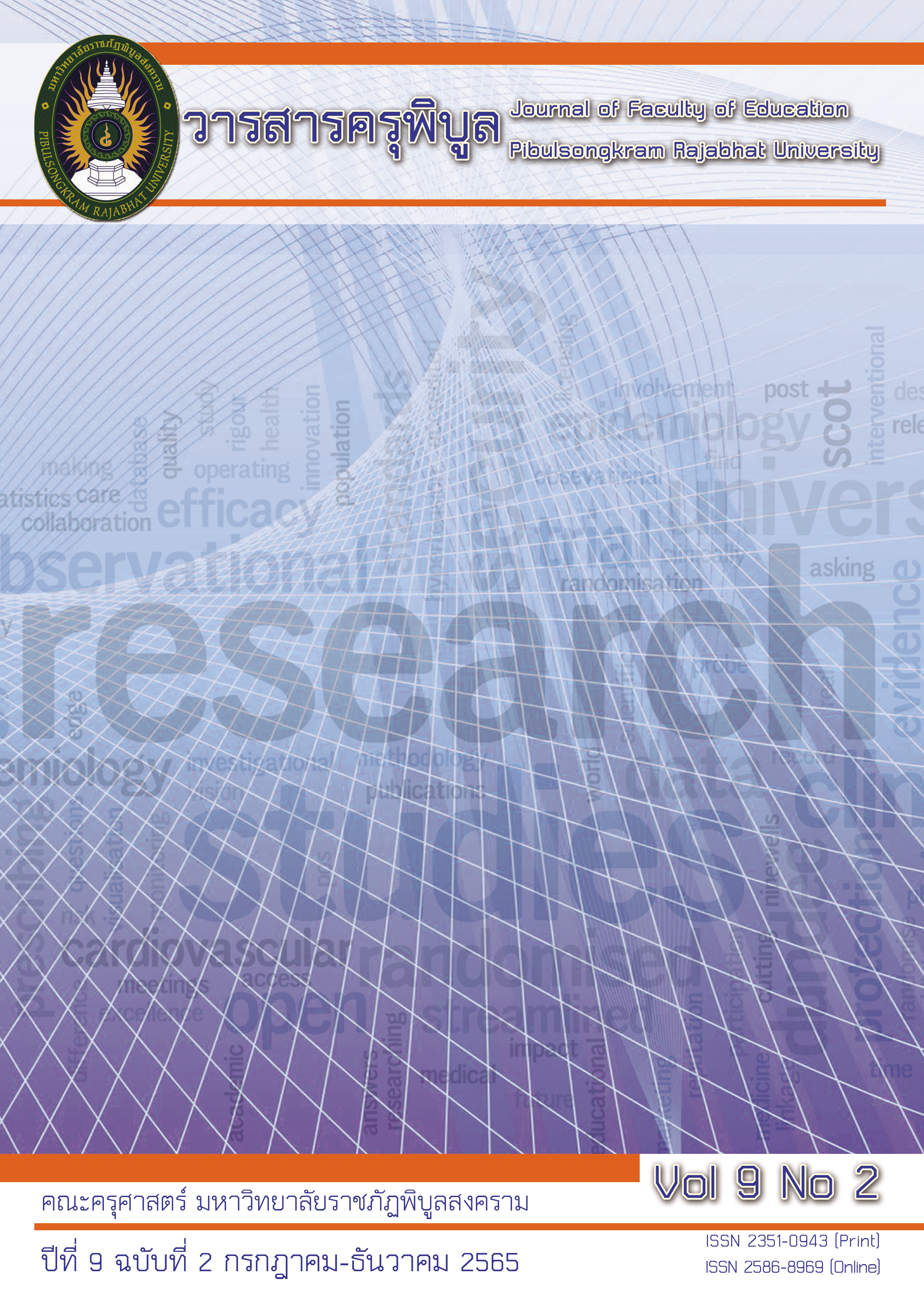A Development of a blended learning model to enhance skills in using google applications and collaborative learning for students of the faculty of education, Thaksin University.
การพัฒนารูปแบบการเรียนการสอนแบบผสมผสานเพื่อเสริมสร้างทักษะการใช้ Google Application และการเรียนรู้แบบร่วมมือสำหรับนิสิต คณะศึกษาศาสตร์ มหาวิทยาลัยทักษิณ
คำสำคัญ:
teaching and learning model, blended learning, collaborative learningบทคัดย่อ
การวิจัยนี้มีวัตถุประสงค์เพื่อ 1) พัฒนารูปแบบการเรียนการสอนแบบผสมผสานเพื่อเสริมสร้างทักษะการใช้ Google Application และการเรียนรู้แบบร่วมมือสำหรับนิสิตคณะศึกษาศาสตร์ มหาวิทยาลัยทักษิณ 2) ศึกษาทักษะการใช้ Google Application 3) ศึกษาทักษะเรียนรู้แบบร่วมมือ และ 4) ศึกษาความพึงพอใจของนิสิต เก็บข้อมูลกับนิสิตคณะศึกษาศาสตร์ จำนวน 68 คน อาจารย์จำนวน 5 คน การวิจัยระยะที่ 1 พัฒนารูปแบบการเรียนการสอนแบบผสมผสานเพื่อเสริมสร้างทักษะการใช้ Google Application และการเรียนรู้แบบร่วมมือ ระยะที่ 2 ศึกษาผลการใช้รูปแบบการเรียนการสอนแบบผสมผสานเพื่อเสริมสร้างทักษะการใช้ Google Application และการเรียนรู้แบบร่วมมือ สถิติที่ใช้ในการวิเคราะห์ข้อมูล ได้แก่ การทดสอบประสิทธิภาพ 80/80 ค่าร้อยละ ค่าเฉลี่ย ใช้สถิติ t-test dependent ผลการวิจัยพบว่า รูปแบบการเรียนการสอนแบบผสมผสานมี 4 องค์ประกอบหลัก ได้แก่ 1) ปัจจัยนำเข้า 2) กระบวนการ 3) ผลลัพธ์ และ 4) ข้อมูลย้อนกลับ และ 6 องค์ประกอบย่อย ได้แก่ 1) ผู้สอน 2) ผู้เรียน 3) เนื้อหา 4) การจัดกิจกรรมการเรียนรู้ 5) สื่อการเรียนการสอนและแหล่งการเรียนรู้ออนไลน์ 6) การประเมินผล และมี 3 ขั้นตอนคือ ขั้นเตรียมการ ขั้นจัดกิจกรรมการเรียนการสอนและขั้นการประเมินผล รูปแบบการเรียนการสอนมีความเหมาะสมโดยภาพรวมอยู่ในระดับมากที่สุด ( ค่าเฉลี่ย=4.88) มีค่าประสิทธิภาพเท่ากับ 81.16/83.33 นิสิตมีทักษะการใช้ Google Application สูงกว่าเกณฑ์ร้อยละ 80 อย่างมีนัยสำคัญทางสถิติที่ระดับ .01 ทักษะการเรียนรู้แบบร่วมมือสูงกว่าเกณฑ์ร้อยละ 80 อย่างมีนัยสำคัญทางสถิติที่ระดับ .01 และความพึงพอใจโดยภาพรวม อยู่ในระดับมากที่สุด (ค่าเฉลี่ย =4.60)
เอกสารอ้างอิง
กนกพร ฉันทนารุ่งภักดิ์. (2548). การพัฒนารูปแบบการเรียนการสอนบนเว็บแบบผสมผสานด้วยการเรียนการสอนแบบร่วมมือในกลุ่มการเรียนรู้คณิตศาสตร์ของนักเรียนชั้นประถมศึกษาตอนปลาย. วิทยานิพนธ์ปริญญามหาบัณฑิต สาขาวิชาโสตทัศนศึกษา บัณฑิตวิทยาลัย จุฬาลงกรณ์มหาวิทยาลัย.
กาญจนา จัตุพันธ์ และ กาญจนา สานุกูล. (2560). การศึกษารูปแบบการเรียนรู้แบบร่วมมือร่วมใจ (Cooperative learning) ในชั้นเรียน วิชาระบบสุขภาพ กรณีศึกษา นักศึกษาหลักสูตรประกาศนียบัตรสาธารณสุขชั้นสูงเทคนิคเภสัชกรรม วิทยาลัยการสาธารณสุขสิรินธรจังหวัดขอนแก่น. การประชุมหาดใหญ่วิชาการระดับชาติและนานาชาติ มหาวิทยาลัยหาดใหญ่, วันที่ 22 มิถุนายน 2560 ครั้งที่ 8.
กุลธิดา ทุ่งคาใน. (2564). การเรียนรู้แบบผสมผสาน Blended Learning ในวิถี New Normal Blended Learning in a New Normal. ครุศาสตร์สาร. 15(1). 29-43.
ชัยยงค์ พรหมวงศ์. (2548). สามัญทัศน์เทคโนโลยีและสื่อสารการศึกษา ชุดวิชาเทคโนโลยีและสื่อสารการศึกษา หน่วยที่ 1-15. สืบค้นเมื่อวันที่ 20 กันยายน 2563, จาก https://www.stou.ac.th.
ทิศนา แขมมณี. (2551). รูปแบบการเรียนการสอน : ทางเลือกที่หากหลาย. (พิมพ์ครั้งที่ 5). กรุงเทพฯ : สำนักพิมพ์จุฬาลงกรณ์มหาวิทยาลัย.
ธนกร ขันทเขตต์ และคณะ. (2558). การพัฒนารูปแบบการเรียนรู้แบบผสมผสานโดยเน้นคุณลักษณะการรู้เทคโนโลยีสารสนเทศและการสื่อสาร สำหรับนิสิตระดับอุดมศึกษา. วารสารวิชาการและวิจัยสังคมศาสตร์. (10)29, 29-42.
ธีระวงศ์ สายนาโก และคณะ. (2556). การศึกษารูปแบบการเรียนแบบผสมผสานเพื่อฝึกทักษะการปฏิบัติงาน แอนิเมชันเบื้องต้น สำหรับนิสิตปริญญาตรี สาขาวิชาเทคโนโลยีสื่อสารการศึกษา. วารสารบัณฑิตศึกษามหาวิทยาลัยราชภัฏวไลยอลงกรณ์ ในพระบรมราชูปถัมภ์, 7(2), 16-30.
ปณิตา วรรณพิรุณ. (2554). การเรียนแบบผสมผสาน จากแนวคิดสู่การปฏิบัติ Blended Learning: Principles into Practice. วารสารการอาชีวะและเทคนิคศึกษา. 1(2), 43-49.
พระราชบัญญัติการศึกษาแห่งชาติ พ.ศ. 2542. (2542). ราชกิจจานุเบกษา, เล่ม 116, ตอนที่ 74 ก, หน้า 5.
ภาสกร เรืองรอง และคณะ (2562). Blended Learning กับการพัฒนา คุณภาพการศึกษาไทยในศตวรรษที่ 21. สืบค้นเมื่อ 16 กรกฎาคม 2563, จาก http://nueducation2556.blogspot.com/ 2014/02/blended-learning-21.html.
รุจโรน์ แก้วอุไร. (2550). Blended learning การเรียนรู้แบบผสมผสาน. สืบค้นเมื่อ 18 กรกฎาคม 2563, จาก http://www. gotoknow.org/posts/225358.
เสาวรัจ รัตนคำฟู. (2563). วิกฤตโควิด-19 รัฐต้องเร่งลดช่องว่างดิจิทัล เพื่อความเท่าเทียมในห้องเรียนออนไลน์. สืบค้นเมื่อ 10 สิงหาคม 2563, จาก https://tdri.or.th/2020/04/digital-divide-online-education-inequalities/.
อาภรณ์ ใจเที่ยง. (2550). หลักการสอน (ฉบับปรับปรุง). (พิมพ์ครั้งที่ 4). กรุงเทพฯ : โอเดียนสโตร์
เอกชัย เนาวนิช และปณิตา วรรณพิรุณ. (2555). การพัฒนารูปแบบการเรียนการสอนแบบผสมผสานโดยใช้กระบวนการเรียนแบบสืบเสาะหาความรู้ผ่านเอ็มเลิร์นนิงเพื่อพัฒนาทักษะการคิดเชิงตรรกะสำหรับนักศึกษาปริญญาบัณฑิต. วารสารวิทยบริการ, 23(3), 111-135.
อัญชลี ศรีรุ่งเรือง และคณะ (2558). ผลการเรียนแบบผสมผสานด้วยการเรียนแบบร่วมมือวิชาคอมพิวเตอร์ที่มีต่อ ความรู้พื้นฐานด้านสื่อและการทำงานร่วมกับผู้อื่นของนักเรียนชั้นประถมศึกษาปีที่ 6. วิทยานิพนธ์ศึกษาศาสตร์มหาบัณฑิต, บัณฑิตวิทยาลัยมหาวิทยาลัยศิลปากร.
Horn, M.B. and Staker, H. (2011). The Rise of K–12 Blended. Retrieved June 6, 2020, from https://www.christenseninstitute.org/wpcontent/uploads/ 2013/04/The-rise-of-K-12-blended-learning.pdf.
Leshin, C. B., Pollock, J., & Reigeluth, C. M. (1992). Instructional Design Strategies and Tactics. New Jersey : Educational Technology Publication.
Oliver, M. and Trigwell, K. (2005). Can ‘Blended Learning’ Be Redeemed?. e–Learning and Digital Media. 2(1), 17-26.
ดาวน์โหลด
เผยแพร่แล้ว
ฉบับ
ประเภทบทความ
สัญญาอนุญาต
ลิขสิทธิ์ (c) 2022 คณะครุศาสตร์ มหาวิทยาลัยราชภัฏพิบูลสงคราม

อนุญาตภายใต้เงื่อนไข Creative Commons Attribution-NonCommercial-NoDerivatives 4.0 International License.
ลิขสิทธิ์เป็นของคณะครุศาสตร์ มหาวิทยาลัยราชภัฏพิบูลสงคราม


